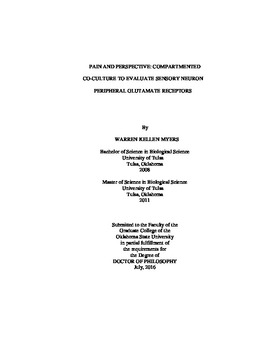| dc.contributor.advisor | Patneau, Doris | |
| dc.contributor.author | Myers, Warren Kellen | |
| dc.date.accessioned | 2017-02-22T22:10:21Z | |
| dc.date.available | 2017-02-22T22:10:21Z | |
| dc.date.issued | 2016-07 | |
| dc.identifier.uri | https://hdl.handle.net/11244/48855 | |
| dc.description.abstract | The neurotransmitter L-Glutamate is the primary excitatory neurotransmitter of sensory neurons in the dorsal root ganglion (DRG). These neurons may also express ionotropic glutamate receptors, causing the potential for them to be directly excited by their own release of glutamate, from a neighboring neuron, or from other tissues. Glutamate is elevated in tissues after injury or inflammation, and iGluR signaling from the periphery has been shown to increase signaling in DRG neurons and contribute to the development of chronic pain. Targeting pharmacologic intervention of sensory neuron iGluRs present in peripheral terminals may constitute an attractive alternative or augmentation to chronic pain treatment regimens. A compartmented culture system was devised to enable the co-culture of sensory neurons and keratinocyte stem cells in discrete compartments to simulate a skin tissue in vitro, and allow focal agonist application to peripheral terminals. Activation of peripheral receptors with focal agonist application caused the propagation of signals towards somata of neurons in a fluidically separated compartment, causing excitatory post-synaptic currents (EPSC) that were observed and recorded via voltage-clamped whole-cell electrophysiology. EPSC responses observed exhibited statistically significant differences between the T values of the EPSCs after respective agonist exposure. Immunofluorescent labeling and visualization of receptor expression showed that iGluR subunits are expressed in sensory neuron somata, sensory neuron peripheral processes, non-neuronal cells from the DRG, and keratinocyte stem cells. The implementation of this co-culture clamping facilitates the spatially discrete interaction of neuronal and non-neuronal cell types for the characterization of their interfaces, as well as for the discrete application of pharmacologic agents along axons to evaluate their spatially constrained influence on activity at a cellular, and intercellular level. The spatially restricted application of agonists represents a chemotransmissive instigation of electrochemical activity in neurons for studying EPSCs, instead of electrically stimulating a presynaptic cell, and so more faithfully represents what would occur in vivo. Using this system to test novel pharmaceuticals represents an intermediary step between the study of ligand interactions with receptors and systemic administration to experimental animals. The identification of the active receptors and their subunit-specific peripheral expression yield alternative therapeutic targets for chronic pain treatment. | |
| dc.format | application/pdf | |
| dc.language | en_US | |
| dc.rights | Copyright is held by the author who has granted the Oklahoma State University Library the non-exclusive right to share this material in its institutional repository. Contact Digital Library Services at lib-dls@okstate.edu or 405-744-9161 for the permission policy on the use, reproduction or distribution of this material. | |
| dc.title | Pain and perspective: Compartmented co-culture to evaluate sensory neuron peripheral glutamate receptors | |
| dc.contributor.committeeMember | Miller, Kenneth | |
| dc.contributor.committeeMember | Koehler, Gerwald | |
| dc.contributor.committeeMember | Payton, Mark | |
| osu.filename | Myers_okstate_0664D_14790.pdf | |
| osu.accesstype | Open Access | |
| dc.type.genre | Dissertation | |
| dc.type.material | Text | |
| thesis.degree.discipline | Biomedical Science | |
| thesis.degree.grantor | Oklahoma State University | |
